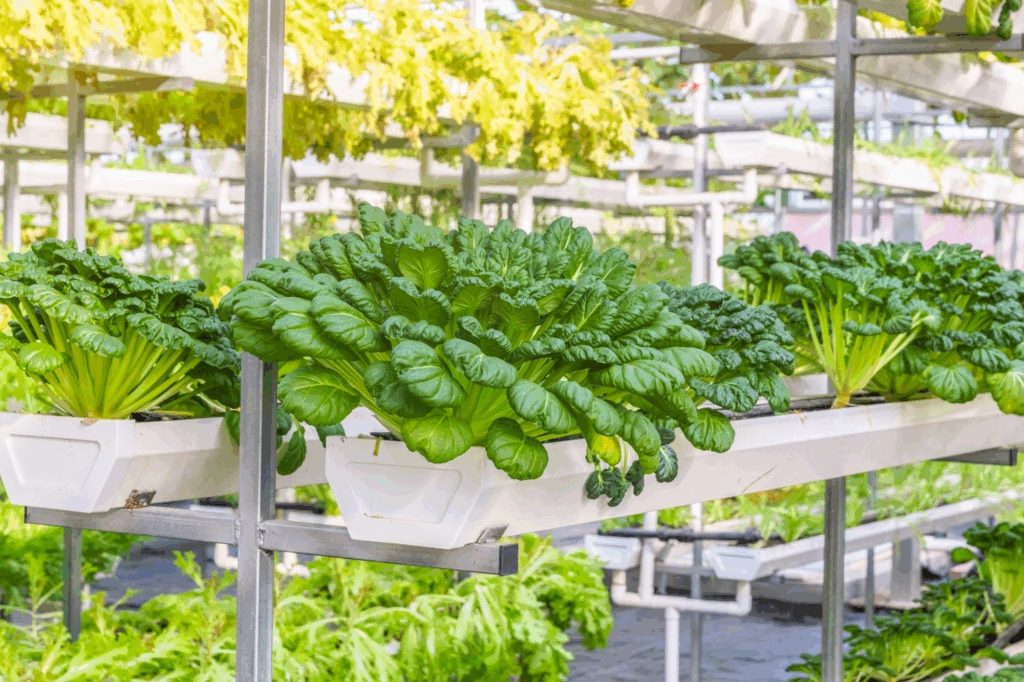Introduction
Hydroponic farming is reshaping agriculture across the globe. Unlike traditional farming that depends on soil, this method grows plants in a nutrient-rich water solution or inert mediums like cocopeat, perlite, or rock wool. It ensures higher yields, better control, and sustainable practices.

In India, where land and water are scarce, hydroponic farming is becoming a preferred choice for modern farming methods (Agzora guide on modern farming). Globally, countries like the Netherlands and the USA have already built billion-dollar industries around hydroponics.
Benefits of Hydroponic Farming
Hydroponics is gaining attention for several reasons:
- Saves Water: Uses up to 90% less water than soil-based farming (FAO report on water-saving agriculture).
- Higher Yields: Vertical setups allow multiple layers of cultivation.
- Pesticide-Free Crops: Ideal for consumers seeking organic farming alternatives (Introduction to Organic Farming – Agzora).
- Year-Round Cultivation: Controlled environments mean crops can grow in any season.
This makes it a sustainable solution for cities and countries struggling with food security.
Types of Hydroponic Systems
Before starting a project, it’s essential to understand the different hydroponic systems:
1. Nutrient Film Technique (NFT)
Water flows over plant roots in a thin film.
2. Deep Water Culture (DWC)
Roots are submerged in nutrient-rich oxygenated water.
3. Drip System
Nutrients are dripped directly at the root zone.
4. Aeroponics
Roots are misted with nutrients in a high-tech setup (NASA research on aeroponics).
5. Wick System
Nutrients move via capillary action through a wick.
Each system has unique applications, from small home projects to large-scale commercial farms.
Starting a Hydroponic Farming Project
A hydroponic farming project requires proper planning and execution.
Step 1: Research and Crop Selection
Choose crops with high demand and shorter growth cycles, such as lettuce, basil, spinach, or strawberries. For more ideas, explore sustainable farming practices on Agzora.
Step 2: Choosing the Right System
Beginners should start with NFT or DWC, while entrepreneurs may invest in aeroponic greenhouses.
Step 3: Infrastructure Setup
A typical project requires:
- Greenhouse or controlled indoor space
- Grow lights (LED preferred)
- Nutrient reservoir, pumps, and monitoring systems
- pH/EC meters to check nutrient balance
Step 4: Preparing Nutrient Solutions
Plants need a mix of nitrogen, phosphorus, potassium, calcium, and trace elements. External resources like Hydroponics Global Market Research show how nutrient technology is evolving to improve yields.
Step 5: Monitoring & Maintenance
Daily checks on pH, oxygen levels, and nutrient composition ensure healthy crops and consistent growth.
Cost of Hydroponic Farming Projects
The investment varies depending on scale:
- Home Garden Setup: ₹5,000 – ₹20,000
- Medium Commercial Farm: ₹1–5 Lakhs
- Large Commercial Project: ₹10 Lakhs+
Although costs are high, ROI is faster due to premium produce prices, urban market demand, and year-round supply.
Hydroponics in India: Future Scope
Hydroponics is gaining momentum in cities like Delhi, Bengaluru, and Mumbai. Startups are using rooftops, warehouses, and even old shipping containers to build hydroponic farms. With government support and subsidies, farmers are shifting to modern sustainable agriculture.
Globally, hydroponics is a multi-billion-dollar industry, and India is catching up quickly. Those who start a hydroponic farming project now will be ahead in this agricultural revolution.
Conclusion
Hydroponic farming is the future of agriculture—a solution that saves water, grows food faster, and supports sustainable living. Whether you want to set up a home-based unit or launch a commercial hydroponic farming project, the opportunity is bigger than ever.
By combining modern farming methods with smart technology, hydroponics can help solve food security challenges while creating profitable business opportunities.





